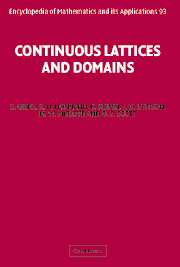Book contents
- Frontmatter
- Contents
- Preface
- Acknowledgments
- Foreword to A Compendium of Continuous Lattices
- Introduction to A Compendium of Continuous Lattices
- O A Primer on Ordered Sets and Lattices
- I Order Theory of Domains
- II The Scott Topology
- III The Lawson Topology
- IV Morphisms and Functors
- V Spectral Theory of Continuous Lattices
- VI Compact Posets and Semilattices
- VII Topological Algebra and Lattice Theory: Applications
- Bibliography
- List of Symbols
- List of Categories
- Index
VI - Compact Posets and Semilattices
Published online by Cambridge University Press: 13 August 2009
- Frontmatter
- Contents
- Preface
- Acknowledgments
- Foreword to A Compendium of Continuous Lattices
- Introduction to A Compendium of Continuous Lattices
- O A Primer on Ordered Sets and Lattices
- I Order Theory of Domains
- II The Scott Topology
- III The Lawson Topology
- IV Morphisms and Functors
- V Spectral Theory of Continuous Lattices
- VI Compact Posets and Semilattices
- VII Topological Algebra and Lattice Theory: Applications
- Bibliography
- List of Symbols
- List of Categories
- Index
Summary
As the title of the chapter indicates, we now turn our attention from the principally algebraic properties of continuous lattices to the position these lattices hold in topological algebra as certain compact semilattices. Indeed, as the Fundamental Theorem VI-3.4 shows, complete continuous semilattices are exactly the compact semilattices with small semilattices in the Lawson topology. Thus, complete continuous semilattices not only comprise an intrinsically important subcategory of the category of compact semilattices but also form the most well-understood category of compact semilattices. In fact, there are only two known examples of compact semilattices which are not complete continuous semilattices; these are presented in Section VI-4. The paucity of such examples attests to the unknown nature of compact semilattices in general.
We begin the chapter with some background remarks on compact pospaces and topological semilattices. This is followed by a order theoretic description of the topology of a compact semilattice in Section VI-2. Starting from any compact topological semilattice whatsoever, we deduce that the topology may be derived from the order. Indeed the topology is a variant “liminf” topology, one considerably more complicated than earlier ones we have considered. This allows order theoretic descriptions of continuous semilattice morphims, closed subsemilattices, etc., much in the spirit that we have already encountered for the Lawson topology is Section III-1.
Information
- Type
- Chapter
- Information
- Continuous Lattices and Domains , pp. 439 - 491Publisher: Cambridge University PressPrint publication year: 2003
